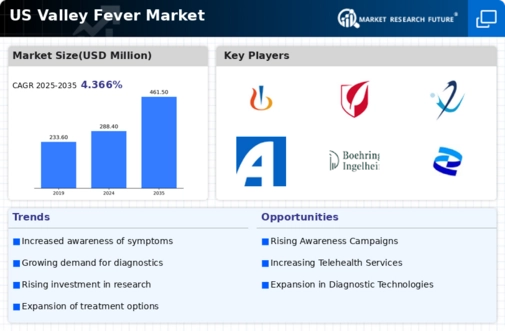Rising Incidence Rates
The valley fever market experiences growth due to the rising incidence rates of coccidioidomycosis, the disease caused by the fungus Coccidioides. In recent years, the number of reported cases has increased, particularly in the southwestern US, where environmental conditions favor the fungus's growth. According to the Centers for Disease Control and Prevention (CDC), the incidence rate has surged, with thousands of cases reported annually. This trend indicates a growing need for effective diagnostics and treatment options, thereby driving the valley fever market. As awareness of the disease spreads, healthcare providers are more likely to seek out innovative solutions, contributing to market expansion. The increasing burden of valley fever on public health systems further emphasizes the necessity for investment in research and development within the valley fever market.
Increased Research Funding
This market is likely to benefit from increased research funding aimed at understanding and combating coccidioidomycosis.. Government and private organizations are recognizing the need for more comprehensive studies on the disease, its epidemiology, and potential treatment options. This influx of funding may lead to breakthroughs in therapeutic development and improved patient care strategies. Research initiatives focusing on vaccine development and novel antifungal agents are particularly promising. As funding continues to grow, the valley fever market may see a surge in innovative products and solutions, addressing the unmet needs of patients. This trend not only enhances the scientific understanding of valley fever but also positions the market for future growth.
Growing Healthcare Expenditure
This market is influenced by the growing healthcare expenditure in the US.. As healthcare budgets expand, there is an increased focus on infectious diseases, including valley fever. This trend is reflected in the allocation of resources towards research, diagnostics, and treatment options for coccidioidomycosis. Higher healthcare spending allows for the development of advanced medical technologies and improved access to care for patients. Additionally, as more healthcare providers recognize the importance of addressing valley fever, the market is likely to see an increase in the availability of diagnostic tests and therapeutic options. This growing investment in healthcare infrastructure may ultimately lead to better management of valley fever cases, thereby enhancing the overall market landscape.
Enhanced Public Health Initiatives
Public health initiatives aimed at increasing awareness and prevention of valley fever are pivotal in shaping the valley fever market. Government agencies and health organizations are actively promoting education about the disease, its symptoms, and preventive measures. These initiatives are crucial in regions where valley fever is endemic, as they encourage early diagnosis and treatment. The CDC has launched campaigns to inform the public about the risks associated with valley fever, which may lead to increased healthcare utilization. As more individuals become aware of the disease, the demand for diagnostic tests and treatment options is likely to rise, thereby stimulating growth in the valley fever market. This proactive approach not only aids in reducing the incidence of the disease but also enhances the overall market landscape.
Technological Advancements in Diagnostics
Technological advancements in diagnostic methods are significantly influencing the valley fever market. Innovations such as molecular testing and serological assays have improved the accuracy and speed of diagnosing valley fever. These advancements allow for earlier detection of the disease, which is crucial for effective treatment. The introduction of rapid diagnostic tests has the potential to enhance patient outcomes and reduce healthcare costs. As healthcare providers increasingly adopt these technologies, the demand for diagnostic tools in the valley fever market is expected to grow. Furthermore, the integration of telemedicine and digital health solutions may facilitate access to diagnostic services, particularly in remote areas. This trend indicates a shift towards more efficient healthcare delivery, ultimately benefiting the valley fever market.




















Leave a Comment